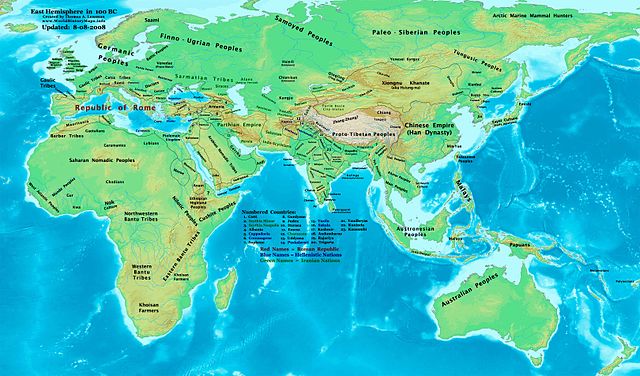
File:East-Hem 100bc.jpg

| |
This is a file from the Wikimedia Commons. Information from its description page there is shown below.
Commons is a freely licensed media file repository. You can help. |
 |
This map image could be recreated using vector graphics as an SVG file. This has several advantages; see Commons:Media for cleanup for more information. If an SVG form of this image is already available, please upload it. After uploading an SVG, replace this template with {{ vector version available|new image name.svg}}. |
| Description |
English: Eastern Hemisphere in 100 BC.
|
||||||
| Date | |||||||
| Source | self-made (For reference information, see below) | ||||||
| Author | Thomas Lessman ( Contact!) | ||||||
| Permission ( Reusing this file) |
|
Contents |
Map Summary
Original Source URL: http://www.thomaslessman.com/History/images/East-Hem_100bc.jpg.
This map of the Eastern Hemisphere in 100 BC was created by Thomas Lessman, based on information from the sources listed below. This map is free for educational use (see Permission info above). When using this map, please mention that it is available for free at www.WorldHistoryMaps.info.
Map Source References
(This section is being revised, please be patient!)
- Remember, sources often conflict with each other. This map is only as accurate as the information that is available to me. To report any errors or to help further this work, please click here, or email Thomas Lessman at talessman@yis.us
References for information contained in this map:
1. Borders of Europe are derived from:
- Roman Empire is well documented. Here are some of the better sources I used:
- * The DK Atlas of World History, 2000 Edition; map of Roman Conquests to 120 BC;(Page 179)
- * This map of the Phases of the Roman Empire by User:Varana.
2. Borders of Asia are derived from the following sources:
- Armenia borders derive from the map of the Armenian Empire, 95-66 BC under Tigranes the Great.
- Atropatene borders come from this map of the Armenian Empire, 95-66 BC under Tigranes the Great.
- Indo-Greek Kingdoms are derived from:
- * Wikimedia's map of the World in 100 BCE.PNG by User:Javierfv1212.
- Judea borders are derived from:
- * Wikipedia's article on the Hasmonean Kingdom,
- * This map of the Armenian Empire, 95-66 BC under Tigranes the Great.
- * This map of Israeli Borders, 167-76 BC (available on Livius.org).
- Kashmir under the Saka King Maues, is described on the Iranica.com article about the Indo-Scythians
- Mahameghavahanas are shown in Wikimedia's map of the World in 100 BCE.PNG by User:Javierfv1212.
- Palmyra borders are derived from Wikipedia's article about Palmyra, and from Wikimedia's map of the World in 100 BCE.PNG by User:Javierfv1212.
- Parthian Empire borders are derived from
- Persia borders are shown in the WorldHistoryMaps.com map of the old world in 036 BC and their map of 150 BC.
- Pontus borders are derived from this map of the Armenian Empire, 95-66 BC under Tigranes the Great.
- Ptolemaic Kingdom
- Sakastan borders come from this map of Sakastan in 100 BC, available on Wikipedia's article on Sakastan.
- Satavahana Dynasty
- Seleucia borders are derived from this map of the Armenian Empire, 95-66 BC under Tigranes the Great.
- * Note: Seleucid rule over the "spur" of land west of Judea is derived from William R. Shepherd's map of The Growth of Roman Power in Asia (Asia Minor II).
- Sunga Dynasty
3. Fringe areas like Africa, Australia, Siberia, etc. are derived mostly from Wikimedia's map of the World in 100 BCE.PNG by User:Javierfv1212.
4. Much of the information in this map was cross-checked with Bruce Gordon's Regnal Chronologies.
Other Maps by Thomas Lessman
| Maps of the eastern hemisphere showing history Bold dates are available on Wikimedia or Wikipedia. |
||
| Primeval |
·| 1300 BC | 1000 BC | 625 BC | |
|
|
|
||
| Ancient BC / BCE
AD / CE |
·| 600 BC | 550 BC | 527 BC | 500 BC | 400 BC | ·| 1 AD | 50 AD | 100 AD | 200 AD | 300 AD | |
|
| Medieval |
·| 500 AD | 565 AD | 600 AD | 700 AD | |
|
| Modern |
·| 1500 AD | · * For historical maps of the whole world, |
|
| history links talk edit view | ||
Other Information
Previous
File usage
Did you know...?
SOS Children's Villages aims to make Wikipedia suitable for young learners. In 133 nations around the world, SOS Children works to bring better education and healthcare to families in desperate need of support. Find out how you can help children in other countries.
